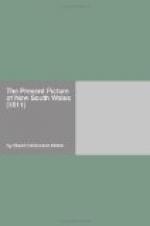At the close of the year 1795, the public and private stock of the colony consisted of 57 horses and mares, 101 cows and cow-calves, 74 bulls and bull-calves, 52 oxen, 1531 sheep, 1427 goats, and 1869 hogs: exclusive of this statement, the poultry was exceedingly numerous. The total of the land in cultivation amounted to 5419 acres; the quantity of which sown was somewhat below 3000 acres. At this period the storehouses were exhausted so completely, that, on the arrival of Governor Hunter, there were no salt provisions left in store, and the allowance of other food was much reduced; the state of the colony seemed about to assume a retrograde movement, and it was only the speedy arrival of a storeship at this critical and distressing moment, which saved it from destruction, in the eighth year of its establishment.
But at the commencement of the nineteenth century, the state of the settlement was abundantly more prosperous. The live stock at this period, in the public and private possession, amounted to the following numbers:—60 horses, 143 mares; 332 bulls and oxen, 712 cows; 2031 male sheep, 4093 females; 727 male goats, 1455 females; 4017 hogs—a prodigious multiplication of the means of subsistence in about five years! The quantity of land sown with wheat was 46653/4 acres, of Indian corn 2930, and of barley 82 acres. In New South Wales and Norfolk Island the numbers of the colony had been swollen to the amount of six thousand, and the general prosperity appeared rapidly increasing.
The moment of the governor’s departure was a moment of sorrowful agitation: loved and honoured by all, he was attended by a numerous train of civil and military officers, as well as a long concourse of the grateful inhabitants, who, at this distressing instant, marked in the most unequivocal manner the sense they entertained of his public worth and his private benignity.
On the secession of Governor Hunter, the government of the settlement devolved to Governor King, who had arrived from England in the Speedy, a few months previous to this time. Soon after his accession to this dignity, a quantity of copper coin was received from England and put into circulation, upon which occasion the following table of specie was issued:—A guinea, one pound two shillings, a johannes, four pounds; a half ditto, two pounds; a ducat, nine shillings and sixpence; a gold mohur, one pound seventeen shillings and sixpence; a pagoda, eight shillings; a Spanish dollar, five shillings; a rupee, two shillings and sixpence; a Dutch guilder, two shillings; an English shilling, one shilling and one penny: a copper coin of one ounce, two pence; a ditto of half an ounce, one penny; and a ditto of a quarter of an ounce, a halfpenny. No sum exceeding five pounds, in the copper coin, was to be considered as a legal tender; and the exportation or importation of copper coin above that amount, was prohibited under a penalty of thrice its value.




